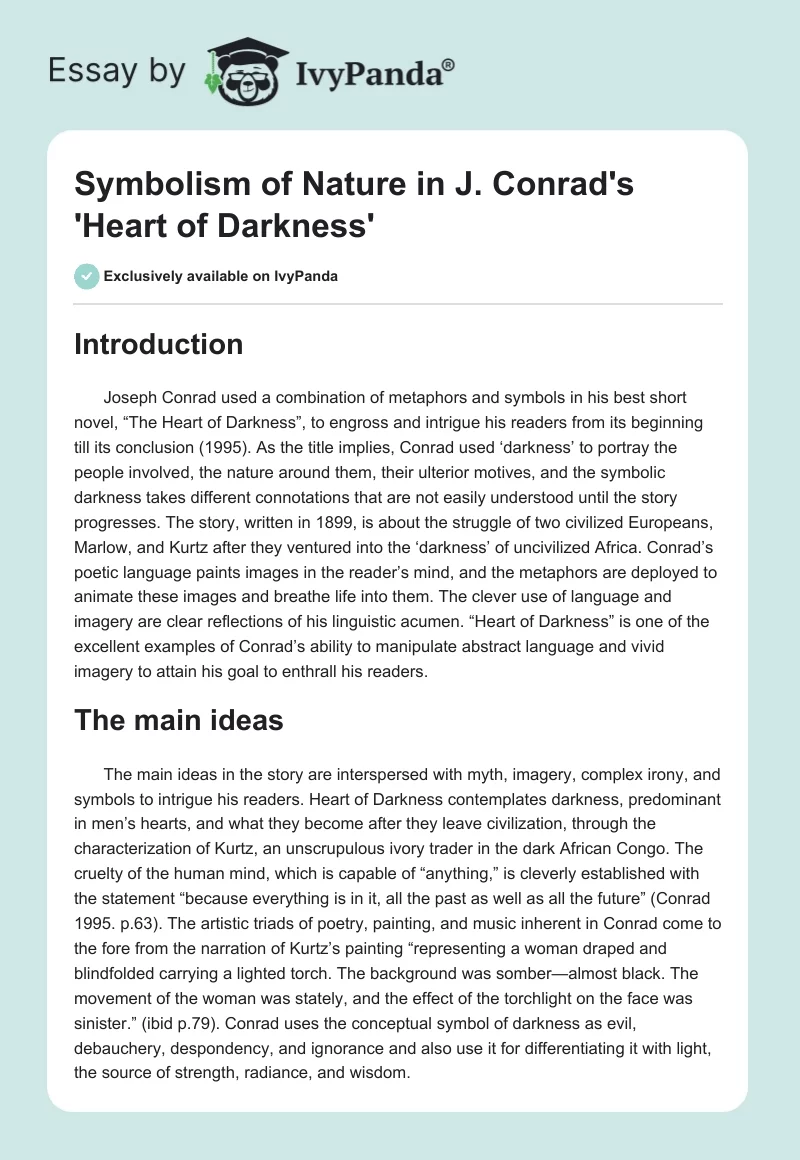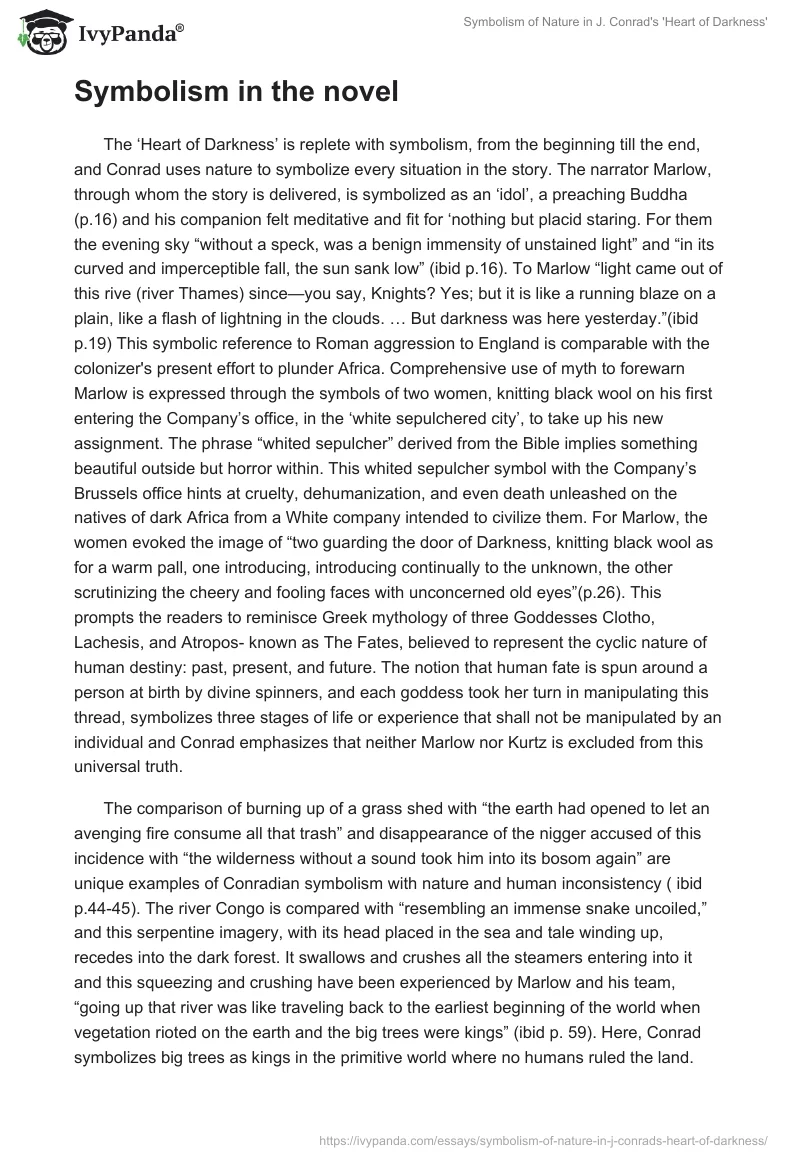Introduction
Joseph Conrad used a combination of metaphors and symbols in his best short novel, “The Heart of Darkness”, to engross and intrigue his readers from its beginning till its conclusion (1995). As the title implies, Conrad used ‘darkness’ to portray the people involved, the nature around them, their ulterior motives, and the symbolic darkness takes different connotations that are not easily understood until the story progresses.
The story, written in 1899, is about the struggle of two civilized Europeans, Marlow, and Kurtz after they ventured into the ‘darkness’ of uncivilized Africa. Conrad’s poetic language paints images in the reader’s mind, and the metaphors are deployed to animate these images and breathe life into them. The clever use of language and imagery are clear reflections of his linguistic acumen. “Heart of Darkness” is one of the excellent examples of Conrad’s ability to manipulate abstract language and vivid imagery to attain his goal to enthrall his readers.
The Main Ideas
The main ideas in the story are interspersed with myth, imagery, complex irony, and symbols to intrigue his readers. Heart of Darkness contemplates darkness, predominant in men’s hearts, and what they become after they leave civilization, through the characterization of Kurtz, an unscrupulous ivory trader in the dark African Congo. The cruelty of the human mind, which is capable of “anything,” is cleverly established with the statement “because everything is in it, all the past as well as all the future” (Conrad 1995. p.63).
The artistic triads of poetry, painting, and music inherent in Conrad come to the fore from the narration of Kurtz’s painting “representing a woman draped and blindfolded carrying a lighted torch. The background was somber—almost black. The movement of the woman was stately, and the effect of the torchlight on the face was sinister.” (ibid p.79). Conrad uses the conceptual symbol of darkness as evil, debauchery, despondency, and ignorance and also use it for differentiating it with light, the source of strength, radiance, and wisdom.
Symbolism in the Novel
The ‘Heart of Darkness’ is replete with symbolism, from the beginning till the end, and Conrad uses nature to symbolize every situation in the story. The narrator Marlow, through whom the story is delivered, is symbolized as an ‘idol’, a preaching Buddha (p.16) and his companion felt meditative and fit for ‘nothing but placid staring. For them the evening sky “without a speck, was a benign immensity of unstained light” and “in its curved and imperceptible fall, the sun sank low” (ibid p.16).
To Marlow “light came out of this rive (river Thames) since—you say, Knights? Yes; but it is like a running blaze on a plain, like a flash of lightning in the clouds. … But darkness was here yesterday.”(ibid p.19) This symbolic reference to Roman aggression to England is comparable with the colonizer’s present effort to plunder Africa. Comprehensive use of myth to forewarn Marlow is expressed through the symbols of two women, knitting black wool on his first entering the Company’s office, in the ‘white sepulchered city’, to take up his new assignment.
The phrase “whited sepulcher” derived from the Bible implies something beautiful outside but horror within. This whited sepulcher symbol with the Company’s Brussels office hints at cruelty, dehumanization, and even death unleashed on the natives of dark Africa from a White company intended to civilize them. For Marlow, the women evoked the image of “two guarding the door of Darkness, knitting black wool as for a warm pall, one introducing, introducing continually to the unknown, the other scrutinizing the cheery and fooling faces with unconcerned old eyes”(p.26). This prompts the readers to reminisce Greek mythology of three Goddesses Clotho, Lachesis, and Atropos- known as The Fates, believed to represent the cyclic nature of human destiny: past, present, and future.
The notion that human fate is spun around a person at birth by divine spinners, and each goddess took her turn in manipulating this thread, symbolizes three stages of life or experience that shall not be manipulated by an individual and Conrad emphasizes that neither Marlow nor Kurtz is excluded from this universal truth.
The comparison of burning up of a grass shed with “the earth had opened to let an avenging fire consume all that trash” and disappearance of the nigger accused of this incidence with “the wilderness without a sound took him into its bosom again” are unique examples of Conradian symbolism with nature and human inconsistency ( ibid p.44-45).
The river Congo is compared with “resembling an immense snake uncoiled,” and this serpentine imagery, with its head placed in the sea and tale winding up, recedes into the dark forest. It swallows and crushes all the steamers entering into it and this squeezing and crushing have been experienced by Marlow and his team, “going up that river was like traveling back to the earliest beginning of the world when vegetation rioted on the earth and the big trees were kings” (ibid p. 59). Here, Conrad symbolizes big trees as kings in the primitive world where no humans ruled the land.
The journey upstream of river Congo, through “trees, trees, millions of trees, massive, immense, running up high, and at their foot, hugging the bank against the stream” by the steamer like sluggish beetle depicts the supremacy of nature and inability of humans to surmount it (ibid p.61). They were “wanderers on a prehistoric earth” the earth seemed ‘unearthly’ where the inhabitants were not inhuman, but “remote kin” (p. 62-63).
Marlow’s words that “I tried to break the spell–the heavy, mute spell of the wilderness—that seemed to draw him to its pitiless breast by the awakening of forgotten brutal instincts by the memory of gratified and monstrous passions,” when he encountered Kurtz in the dark island are another allegorical situation with wild nature and downfall of an idolized civilized man, Kurtz (ibid p. 106-107).
Ultimately Conrad pays his obituary to Kurtz with his typical irony that the “shade of the original Kurtz” who was an “impenetrable darkness” “whose fate it was to be buried presently in the mold of primeval earth” (ibid p.110-111). As a classic writer, Conrad successfully stimulates and excites the mind of his readers, through the clever use of symbols of nature to convey the sense of realism, in his novella “Heart of Darkness.”
References
Conrad, Joseph. 1995. Heart of Darkness with the Congo Diary. Hampson, Robert. (Ed.) London: Penguin.


